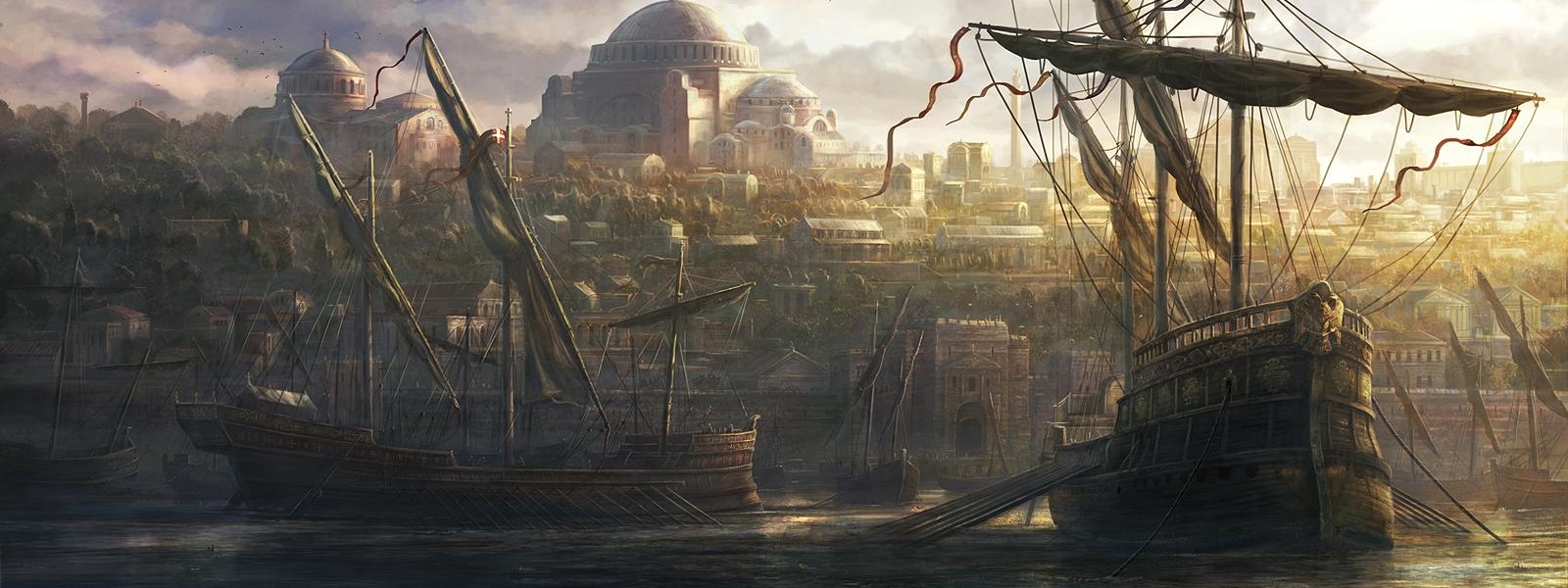Apepsos (/ eipepsos /)
Απεπσοσ
As you pass the gates of Apepsos, you find yourself overwhelmed by the sheer scale of the city, far larger than most and Galisea, and bathed in history. The ancient monuments calling out in recognition of a sundered empire, and its grand civic buildings evoke the image of a powerful ruler, though all have seen better days. Despite the hum of commerce and ringing of hammers in the manufactories, you can't help but feel you are looking upon a great city in its last days of glory.The city of Apepsos is one of the oldest continually inhabited cities in the Aeillan region. It remains one of the most important cities in the region, though its status as the cultural and political capital of the Aeillan region has gone into steady decline throughout the post-Imperial period, as the more mercantile coastal powers and their associated cities have gotten steadily more influential.
Wards of Apepsos
There are 8 major wards of Apepsos and a small district completes the noteworthy neighborhoods of the city. Most of the old money lies within the walls, though the newborn industrial sector has centered itself outside the city walls along the banks of the Ilos River:Palace Hill: Centered around the Imperial Palace, and its immediate surroundings. This area is known for ancient patrician families and old money where the eldest aristocratic houses maintain relatively small estates close to the seat of power in the city.
Senate Ward: The second major political center of the city, the Senate Ward consists of the Senate Building, the Imperial Forum, major governmental buildings, and estates for the newer families of the Peptid Aristocracy.
The Agora: The primary market district of the city, the Agora is home to the city's main marketplace, shops for skilled tradesfolk, and the homes of most of the merchants in the city. Though this region is primarily home for small traders and craftspeople moreso than it is for the extremely wealthy people in the region.
The Denarium: The Denarium, consisting of neighborhoods in the south of the walled-off portions of the city, the Denarium is often home to the wealthiest of the merchant class, as well as military officers, and the middle management of the civil service, as well as hosting the Sofipolis, the oldest and largest academic university in Aeilla.
The Viatoria: The oldest of the outer wards of the city the Viatoria is largely home to well-established families of the city that are of the working classes, military families, civil servants, and some members of influential craft guilds.
The Vialaria: Essentially a slum district, the Vialaria is one of the older outer wards, where systemic poverty is rife. The residents of the Vialaria are often indentured workers or members of the city's agricultural workforce.
The Locks: The Locks district serves as the primary export center of the city, with wealthy merchants from the city, and foreign traders doing business near the primary artery of commerce running through the city. Here, foreign goods are exchanged for textiles and manufactured goods from the nearby workhouses and fabricae.
The Fabrica Ward: Host to most of the lower-skilled trade centers, the Fabrica Ward is the center of mass production in the city, though it is a relatively new section of the city, it has grown rapidly in the past few years, as Cyrenic experts have moved in to the city and provided their expertise in the construction of mills and manufactories.
The Workhouse Ward: A poorer neighborhood, the workhouse ward consists of collective housing mostly used for workers for the Fabrica Ward and on the Locks, and their families. Poverty is great here, though not to the same extent as the Vialaria.
Important Locations
The Agora: The cultural center of the city, the Agora is home to the city's primary consumer markets, most of the city's major temples, and is often where most major festivals are celebrated. Though it is difficult for adventurers to find goods they need, work is easier to find in the back alleys of the Agora.The Locks Bazaar: The Locks Bazaar is host to markets more suited for nonresidents of the city, here, a lot of the goods needed to conduct an adventure can be found, as a lot of things such as weapons, armor, and even magic items can be found here, but maybe outright illegal in the city proper.
The Imperial Mausoleum: Home to the sacred dead of the Rauros dynasty this place is where one might encounter a number of clerics who can provide magical services, as well as potentially place of worship for Pandroi followers of the Aeillan sect.
The Sofipolis: The oldest, and largest academic university in the Aeillan region. Many scholars are trained here, the teachers of the school are experts in a range of fields, often able to provide a wealth of information for anyone who seeks them out.
The Imperial Palace: Home to much of the city's government, the Imperial Palace often hosts massive dress balls where the city's elite gather. Many contract negotiations and criminal plots occur at these massive balls. However, security at such events is incredibly tight, largely as a result of numerous attempted assassinations over the years.
The City Works: The city works, are a series of major aqueducts and sewers that are navigable. There are rumors that the city's Thieve's Guild operates a base in the works, and many an adventuring party can find easy work assisting the civil service in clearing out unwholesome creatures interrupting their work.
The Geimanswerk: A workhouse owned by a prominent family that had migrated from Volgeberg the Geimanswerk is a clockwork factory that produces some of the finest clocks available south of the Nabari Plateau, if at an alarmingly slow rate. The owning family does, however, pay dearly for adventurers willing to clear out mines and ruins and to obtain resources they use in their work.
Demographics
The city of Apepsos is truly massive, with a population of 260,541, most of whom are indentured servants (10,510), slaves (47,151), or noncitizen freemen (132,901), with only 69,979 citizens of the Exarchate of Apepsos living in the city. Most of the population (190,462) are humans with Ilosi peoples being, by far, the most common. There is a sizable population of nonhuman residents (70,079), with a relatively even split between Grecci and Cyrenic professionals, as well as smatterings of other free peoples, enslaved members of the Terruk, Nabari, and Aarumite peoples, and indentured servants from far off lands. There is a sizable number of aristocrats (15,621) people who live in the city during at least part of the year.
Government
Apepsos is governed directly by the Exarch of Apepsos, though predominantly as the first citizen of the Exarchate, rather than as a dominator of the scene, and there is a fairly well-developed civil service that runs the government on a daily basis. Law enforcement is carried out by the local Reave, acting on behalf of the Senate, and the Peptid Exarch, and there exists a nascent civil service dedicated to maintaining public works in the city.
Defences
The city of Apepsos or at least is older, and wealthier wards are protected by an ancient city wall that dates back to the time of the Ilosi Republic. These walls are protected, and order maintained by 2,100 city watchmen, as well as a mostly permanent garrison of 300 Penandroi, and a Bandon of Hetairoi that also protect the city when not on campaign. These forces are well equipped with the city watch itself given modern weapons and armor. Additionally, they can be augmented by nearby garrisons relatively quickly, with Adinos being a ready provider of additional soldiers.
Industry & Trade
Apepsos is one of the most heavily industrialized cities outside of Cyrenica, and Volgeberg with numerous sizable workshops, mills, and other buildings that power the manufacturing of goods in the city. Most of the goods are made for use directly by the state, though there exists a small but growing sector of consumer goods manufacturing, primarily raw textiles, and some smithied goods made in large collective workhouses. Trade is conducted primarily on the Ilos River, with the locks ward of the city being a major export hub for the whole of the Exarchate of Nikea. The other major center is the Agora, which is an import hub and a market primarily suited to meeting the needs of the city's citizens.
Infrastructure
The city of Apepsos, as one of the oldest continually inhabited cities in the Aeillan region, is also one of its most well-developed infrastructurally. There are a series of aqueducts that provide water to the city, and a sewer network that sends waste into the Ilos River and its tributaries. Streetlights, though not common exist in most of the wealthier wards of the city. The city of Apepsos is a point of convergence for 5 major roads, and there is some automated transport from the mines into the fabricae making Apepsos a major transport hub.
Guilds and Factions
Most of the temporal power is shared between the reigning Exarch and the Senate which are largely cooperative in protecting the status quo of the Exarchy and maintaining peace and order in the city. Counter to this is the Thieve's Guild of Apepsos, which was historically an extralegal body meant to keep crime more or less contained, but has become increasingly subversive in recent years as the Exarchate who have gone into decline. Additionally, the Smith's Guild, which was historically a trade guild for blacksmiths and silversmiths in the city, has expanded and become more radical, largely as a result of funds and agents from the Exarchate of Nikea.
History
The city of Apepsos itself was founded as an independent community during the reign of the Yulan-Tai as one of the few settlements in the region that was, mostly, free of Yulan-Tai control. It was fairly small throughout the Yulan-Tai period, with its first dramatic expansion coming from the flood of refugees fleeing from the Ascension of the Yuan-Ti and during the decline and fall of the Yulan-Tai Empire.
Apepsos was one of the foundational members of the Ilosi League, eventually becoming the center of the Ilosi Republic and its capital. The city of Apepsos quickly became the beating heart of what would eventually become the Aeillan Empire, and the relatively stable core of Aeillan power throughout the Imperial Period, eventually becoming the largest surviving Aeillan city, and the headquarters of Aeillan resistance against Feloran colonization.
After the collapse of the Aeillan Empire, Apepsos lost its status as one of the safest places in the region, as the Succession War made Apepsos a prime target, and the city suffered a number of sackings during this period. Though the city recovered from the damages caused by the early post-Imperial period, it has gone into slow decline as the political centers of power in Aeilla shift from the interior to the coast.
Geography
The city of Apepsos lies on mostly hilly terrain, along the banks of the Ilos River, though historically there was a waterfall that dominated the river near the city, this was replaced by a massive set of locks during the early High Imperial, allowing travel all the way up the Ilos River instead of placing Apepsos at the river's head of navigation. Aside from the locks, the most defining feature of the city is Palace hill, where the Old Imperial Palace is located.

Map of Apepsos by Javak
Founding Date
EY 962
Type
Large city
Population
260,541
Inhabitant Demonym
Peptid, Peptids
Location under
Included Locations
Owner/Ruler
Ruling/Owning Rank
Owning Organization



